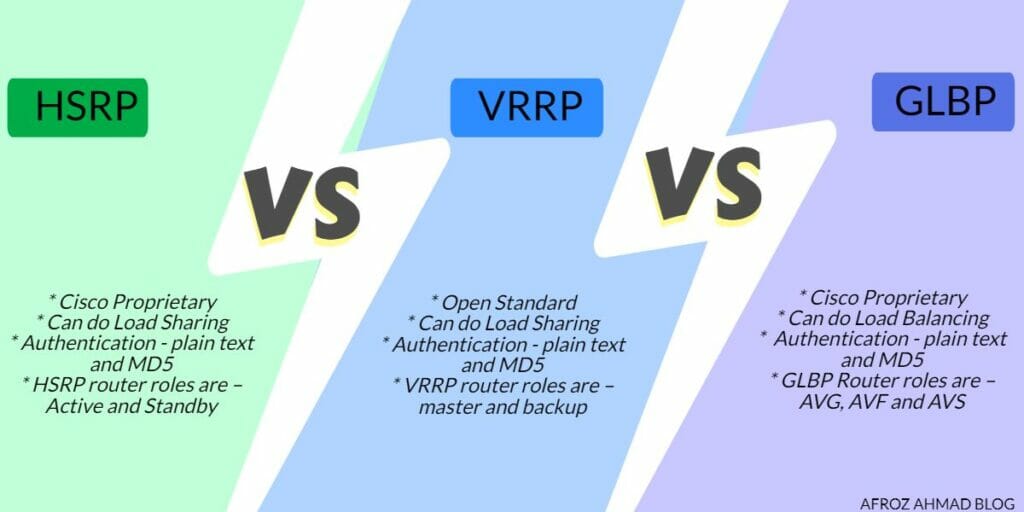Which one to use while deciding between HSRP vs VRRP vs GLBP? This is really a matter of the type of equipment at your disposal, network design complexity, or sometimes personal preference. I have already written articles explaining HSRP, VRRP, and GLBP separately. All three are First Hop Redundancy Protocols and network layer protocols and are used to provide redundancy in the network.
The main difference is that VRRP is industry-standard while HSRP and GLBP are Cisco-proprietary protocols. VRRP and HSRP target a single layer3 ethernet switch or a router to be the active one in a group, whereas GLBP can distribute the responsibility among up to four routers by configuring load balancing schemes. It is mostly recommended to use GLBP in a four-router setup where load balancing is required; the rest everywhere else HSRP or VRRP is more than sufficient to make things work.
GLBP also has a weighting mechanism so that the primary router gets the majority of the traffic, whereas other routers will be load-balancing. Ultimately it depends on your manufacturer’s support. If you are running a Cisco router, you can configure either VRRP, HSRP, or GLBP, but if you have a different vendor device, then you are mostly stuck with VRRP in this case.

I have tried my best to compare these three protocols in the below table. Please check it out and let me know if you have questions.
HSRP vs VRRP vs GLBP Protocol Similarities and Differences
| Number | Criteria | VRRP | HSRP | GLBP |
|---|---|---|---|---|
| 1. | Open Standard or Proprietary | Open IEEE Standard | Cisco Proprietary Protocol | Cisco Proprietary Protocol |
| 2. | First Hop Redundancy Protocol or Not ? | It is an FHRP | It is an FHRP | It is an FHRP |
| 3. | Timers | Default Hello – 1 Sec Hold Time – Calculated Automatically and Can’t be configured – VRRP unlike HSRP can be configured to inherit the timer values configured on the VRRP Master. | Default Hello – 3 Secs Default Hold/Dead Time – 10 Secs | Default Hello – 3 Secs Default Hold/DeadTime – 10 Secs |
| 4. | RFC | 5798 | 2281 | No RFC |
| 5. | Authentication | Plain text and MD5 | Plain text and MD5 | Plain text and MD5 |
| 6. | Preemption | Preemption is enabled by default | Preemption is NOT enabled by default | Preemption is NOT enabled by default for AVGs. Preemption is enabled by default for AVFs. |
| 7. | Router Roles | Concept of master and backup router roles | Cisco HSRP router roles are – Active and Standby | GLBP Router roles are – AVG, AVF and AVS |
| 8. | Versions | No Versions | Two HSRP Version – V1 and V2 | No Versions |
| 9. | Criteria to decide which router will become Master/Active | Based on Highest Priority – If Priority is a tie then the highest IP address becomes Master Router | Based on Highest Priority – If Priority is a tie then the highest IP address becomes Master Router | Based on Highest Priority – If Priority is a tie then the highest IP address becomes Master Router |
| 10. | Packets Delivery | VRRP uses its own IP protocol 112 with multicast destination address 224.0.0.18. | HSRP Version 1 – Packets are sent to the multicast address 224.0.0.2 with TTL 1, which uses UDP port 1985. HSRP Version 2 – Packets are sent to the multicast address 224.0.0.102 with TTL 1, using UDP port 1985. | GLBP packets are sent to the multicast address 224.0.0.102 with a TTL of 1, which uses UDP port 3222 (source and destination). |
| 11. | Virtual MAC Address Format | Format: 0000.5e00.01xx – where XX is the VRRP group number in hex | Format: 0000.0c07.acXX – where XX is the HSRP group number in HEX | Format: 0007.b4XX.XXYY Where XX.XX = 6 zero bits(empty) and 10 bits for the Group number. Where YY = AVF number. |
| 12. | Load Balancing | Load Balancing Not Supported – Load Sharing can be done by configuring multiple groups in a single subnet/Interface | Load Balancing Not Supported – Load Sharing can be done by configuring multiple groups in a single subnet/Interface | Load Balancing Supported - 3 Load Balancing Schemes – Round-Robin (Default), Host-Dependent, Weighted |
| 13. | Sample Config | VRRP Configuration Example – > interface Fa0/0 > ip address ip-address mask > vrrp group description text > vrrp group preempt [delay minimum seconds] > vrrp {group} ip {IP} vrrp {group} timers advertise [msec] {sec/msec} > vrrp {group} timers learn vrrp {group} priority {1-255} > vrrp {group} authentication | HSRP Configuration Example – > interface fa0/0 > standby [group] ip {virtual-ip} > standby [group] timers {hello} {hold-time} > standby [group] priority {1-255} > standby [group] preempt > standby {group} authentication > standby {group} track {object} decrement {no} | GLBP Configuration Example – > interface Fa0/0 > glbp group ip [ip-address [secondary ] > glbp group timers [msec ] hellotime [msec ] holdtime > glbp group timers redirect redirect timeout > glbp group load-balancing [host-dependent | round-robin | weighted ] > glbp group priority level > glbp group preempt [delay minimum seconds] > no glbp {group} forwarder preempt [delay sec] > glbp group weighting track {no} [decrement] > glbp group client-cache maximum number [timeout minutes] |
| 14. | Virtual IP Address | To assign a default gateway to the hosts of a subnet or network, all FHRP protocols, including HSRP, VRRP, and GLBP, use the concept of virtual IP address. | To assign a default gateway to the hosts of a subnet or network, all FHRP protocols, including HSRP, VRRP, and GLBP, use the concept of virtual IP address. | To assign a default gateway to the hosts of a subnet or network, all FHRP protocols, including HSRP, VRRP, and GLBP, use the concept of virtual IP address. |
| 15. | Ipv6 support | It has a v6 Support in newer codes,- Check with Vendor. | It has v6 Support. | It has v6 Support. |
| 16. | Object Tracking Support | Supports Object Tracking – Check with Vendor | Supports Object Tracking | Supports Object Tracking |
Definitions and Acronyms used in the post
- GLBP : Gateway Load Balancing Protocol
- VRRP : Virtual Router Redundancy Protocol
- HSRP : Hot Standby Router Protocol
- FHRP: First Hop Redundancy Protocol
- AVG : Active Virtual Gateway
- AVS : Active Virtual Standby
- AVFs : Active Virtual Forwarders
- ARP: Address Resolution Protocol
Conclusion
In this post, we looked into similarities and differences between HSRP vs VRRP vs GLBP; all of these protocols provide gateway redundancy and load sharing or balancing features.
If you liked this post, please share it to reach out to other people who might be searching for the same topic.
Frequently Asked Questions on HSRP vs VRRP vs GLBP.
What is the difference between hsrp and vrrp?
The fundamental difference between VRRP and HSRP and GLBP is that VRRP is an industry-standard, whereas HSRP and GLBP are Cisco-proprietary protocols. If you are using a Cisco device, you have the option of configuring VRRP, HSRP, or GLBP; however, if you are using a device from a different manufacturer, you are mostly limited to VRRP in this situation. VRRP, in contrast to HSRP, can be configured to inherit the timer values that have been configured on the VRRP Master.
What is the purpose of hsrp and vrrp?
The primary function of HSRP and VRRP is to allow a router to take over the responsibilities of another router in the event that the other router fails. Both protocols are nearly identical, and each uses a strong heartbeat message between a main and a secondary device to monitor each other and shift users of an active router to standby router if that active router fails.
What is difference between HSRP VRRP and GLBP?
Which one to select when choosing between HSRP, VRRP, and GLBP is largely depends on the type of equipment available, the complexity of the network design, and occasionally personal choice. The primary distinction is that VRRP is an industry-standard protocol, whereas HSRP and GLBP are Cisco-proprietary protocols. VRRP and HSRP designate a single router as the active one in a group, whereas GLBP can share duty among up to four routers via load balancing algorithms. It is generally advised to employ GLBP in a four-router configuration if load balancing is necessary; otherwise, HSRP or VRRP would suffice. GLBP also includes a weighting system, which ensures that the primary router receives the majority of the traffic while the other routers load-balance. Finally, it is dependent on the support provided by your manufacturer. If you’re using Cisco, you can configure VRRP, HSRP, or GLBP, but if you’re using a different vendor device, you’re mainly locked with VRRP.
- Epson EpiqVision Flex CO-W01 Projector Review - February 21, 2025
- How to Log in to Your Netgear Router - January 17, 2025
- Gaimoo GM200 Mini Projector Review - January 12, 2025




